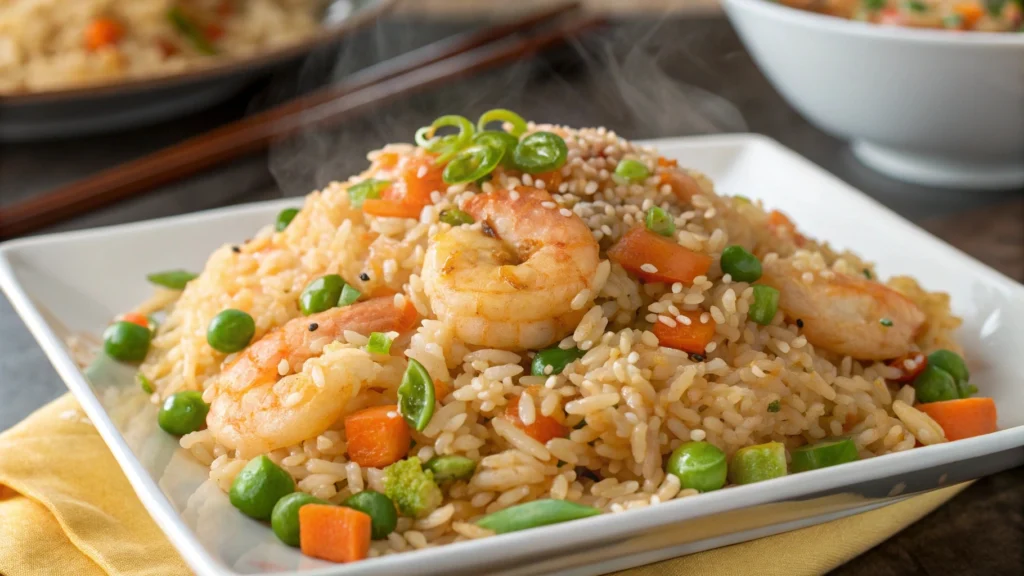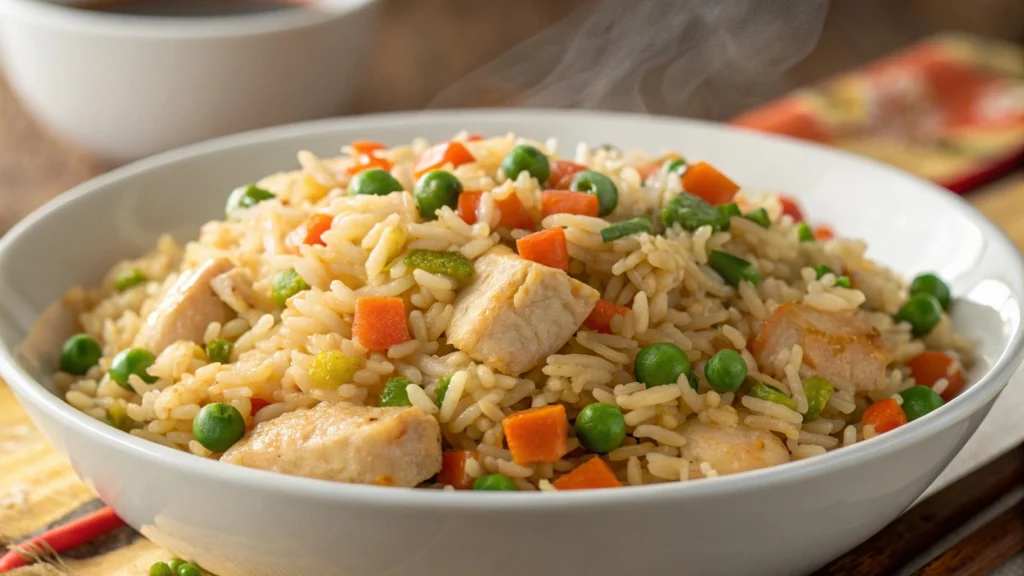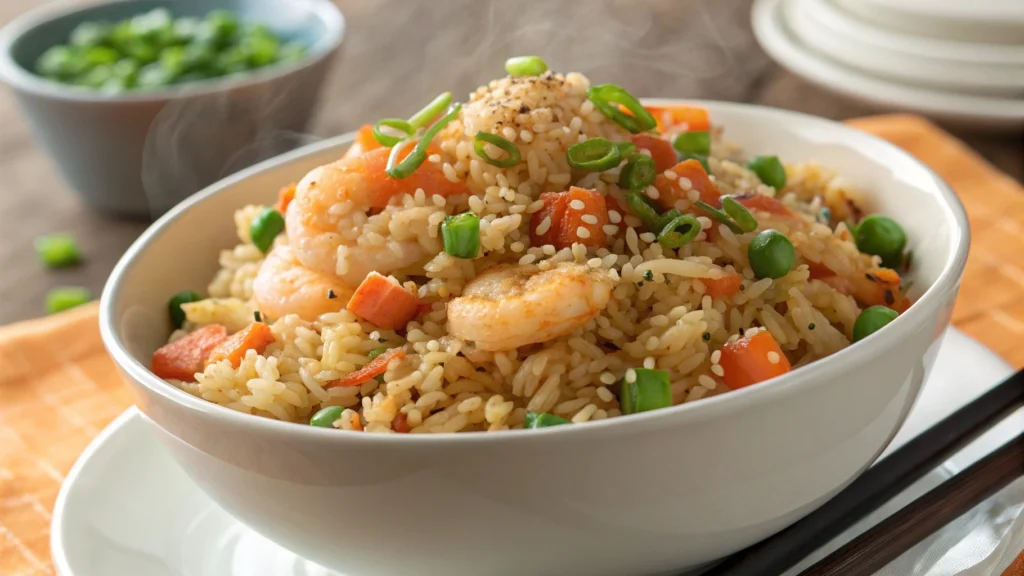Why Fried Rice is More Than Just a Dish

Fried rice isn’t just a meal—it’s a memory, a comfort food, and often the star of your dinner table. Whether you’re reminiscing about that first bite of perfectly seasoned fried rice at your favorite restaurant or trying to recreate a dish your grandma used to make, this humble dish has a way of bringing people together.
And guess what? You don’t need to be a professional chef to master it. With just a few simple ingredients and some easy-to-follow steps, you can whip up a plate of fried rice that rivals any takeout. So grab your wok, prep your ingredients, and let’s dive into how you can create delicious fried rice right in your own kitchen.
1. What You Need to Know About Fried Rice
Before you start cooking, let’s cover the basics. Understanding the essentials will set you up for success and ensure your fried rice turns out flavorful and satisfying every time.
The Best Type of Rice for Fried Rice
- Jasmine rice : Light, fragrant, and perfect for traditional recipes.
- Basmati rice : Adds a nutty aroma, ideal for Indian-inspired variations.
- Leftover rice : Day-old rice works best because it’s drier and less sticky.
- Pro tip: If you don’t have leftover rice, spread freshly cooked rice on a tray and let it cool completely before using.
- Entity: Use a rice cooker to prepare rice ahead of time for convenience.
Essential Ingredients for Flavorful Fried Rice
- Soy sauce : The backbone of flavor in most fried rice dishes.
- Eggs : Scrambled eggs add texture and richness.
- Vegetables : Carrots, peas, bell peppers, and green onions are staples.
- Sesame oil : A drizzle adds an irresistible nutty aroma.
- Variations: Try chicken fried rice , shrimp fried rice , or go vegan-friendly with tofu.
- Entity: Don’t forget garlic and ginger —they’re game-changers for depth of flavor.
Tools You’ll Need to Cook Fried Rice
- Wok : The ultimate tool for stir-frying. If you don’t have one, a large frying pan works too.
- Spatula : A good spatula helps you toss and mix ingredients evenly.
- Knife and cutting board : Prep veggies and proteins efficiently.
- Entity: Keep a wok spatula handy for breaking up clumps of rice.
Common Mistakes to Avoid When Making Fried Rice
- Overloading the wok: Cook in batches if necessary to prevent steaming instead of frying.
- Skipping seasoning: Always taste as you go and adjust flavors like salt , pepper , or soy sauce.
- Blandness: Balance sweet , salty , and umami flavors for a well-rounded dish.
2. Step-by-Step Guide to Making Fried Rice
Now that you know the basics, let’s walk through the process step by step. Follow these instructions carefully, and you’ll have a plate of mouthwatering fried rice in no time.
Preparing Your Ingredients
- Chop your vegetables: Dice carrots, slice bell peppers, and measure out frozen peas.
- Beat eggs: Crack eggs into a bowl, whisk them, and set aside for scrambling.
- Garnish prep: Slice fresh green onions for garnishing at the end.
Cooking the Base: Stir-Frying Vegetables and Protein
- Heat a splash of sesame oil in your wok or frying pan over medium-high heat.
- Add your choice of protein: Chicken, shrimp, or tofu work wonderfully. Stir-fry until cooked through.
- Toss in aromatics: Add minced onions and garlic for a burst of flavor.
Adding the Rice and Seasoning
- Break up clumps of rice with your fingers or spatula before adding to the wok.
- Stir-fry the rice with the other ingredients, ensuring everything is evenly coated.
- Season with soy sauce , a pinch of salt, and optional chili flakes for heat.
Finishing Touches and Garnishes
- Push the rice to one side of the wok and scramble the beaten eggs on the other. Mix them in once cooked.
- Sprinkle chopped green onions over the top for freshness.
- Serve hot with extra soy sauce on the side for those who want more flavor.
3. Variations of Fried Rice to Try
One of the best things about fried rice is its versatility. Here are some creative twists to keep things exciting.
Classic Chinese-Style Fried Rice
- Ingredients: Jasmine rice, soy sauce, sesame oil, carrots, peas, green onions.
- Inspiration: Draw from Chinese cuisine traditions for an authentic taste.
Healthy Vegetable Fried Rice
- Swap white rice for brown rice to boost fiber content.
- Add colorful veggies like zucchini, broccoli, or snap peas.
- Twist: Incorporate turmeric or curry powder for an Indian cuisine flair.
Protein-Packed Chicken or Shrimp Fried Rice
- Marinate chicken or shrimp in soy sauce and ginger before cooking.
- Pair with mushrooms, snap peas, or baby corn for added texture.
- Influence: Add fish sauce or lime juice for a touch of Thai cuisine .
Vegan-Friendly Fried Rice
- Replace animal proteins with tofu or tempeh.
- Use plant-based sauces like tamari or coconut aminos.
- Crunch factor: Sprinkle toasted sesame seeds for extra texture.

4. Tips and Tricks for Perfect Fried Rice
Take your fried rice skills to the next level with these expert tips.
Why Leftover Rice Works Best
- Day-old rice contains less moisture, making it less sticky and easier to fry.
- Tip: Store cooked rice in the fridge overnight using a rice cooker inner pot.
Balancing Flavors in Fried Rice
- Combine sweet (e.g., carrots), salty (e.g., soy sauce), and umami (e.g., oyster sauce) for depth.
- Add grated ginger for an aromatic kick.
How to Make Fried Rice Crispy
- Cook on high heat to achieve a slight char without overcrowding the wok.
- Drizzle sparingly with sesame oil for crispiness.
Storing and Reheating Fried Rice
- Store leftovers in an airtight container in the fridge for up to 3–4 days.
- Reheat in a pan or microwave, adding a splash of water to refresh the texture.
- Meal prep hack: Freeze portions of fried rice for quick lunches.
5. Frequently Asked Questions About Fried Rice
Here are answers to some common questions readers might have about making fried rice.
Can You Use Brown Rice for Fried Rice?
- Yes, but note that brown rice takes longer to cook and has a firmer texture. Adjust accordingly.
Is Fried Rice Healthy?
- It depends on the ingredients. Opt for lean proteins, plenty of veggies, and minimal oil for a healthier version.
How Long Does Fried Rice Last in the Fridge?
- Properly stored, fried rice can last up to 3–4 days in the fridge.
Why Does My Fried Rice Taste Bland?
- Lack of seasoning or improper balance of flavors may be the issue. Taste as you go and adjust with soy sauce, salt, or spices.
6. Elevating Your Fried Rice with Advanced Techniques
Once you’ve mastered the basics, it’s time to take your fried rice to the next level. Here are some advanced techniques and tips that will transform your dish from good to gourmet.
Incorporating Umami Boosters
- Oyster sauce : Adds a rich, savory depth that complements soy sauce beautifully.
- Fish sauce : A staple in Southeast Asian cooking, this adds a subtle oceanic umami flavor.
- Mushrooms : Shiitake or oyster mushrooms can elevate the umami profile naturally.
- Pro tip: Rehydrate dried shiitake mushrooms and use the soaking liquid as a seasoning base.

The Art of Wok Hei (Breath of the Wok)
- What is wok hei? It’s the smoky, charred aroma that comes from high-heat stir-frying in a well-seasoned wok.
- How to achieve it:
- Preheat your wok until it’s smoking hot before adding oil.
- Avoid overcrowding the pan to allow for proper searing.
- Use a flick-and-toss motion to keep ingredients moving constantly.
Playing with Textures
- Add crunch: Toasted nuts like cashews or peanuts can add a delightful contrast to soft rice.
- Creamy element: Stir in a spoonful of cream cheese or coconut milk for a luxurious twist.
- Chewy texture: Include rehydrated dried shrimp or char siu (barbecued pork) for variety.
Experimenting with Regional Flavors
- Korean-inspired : Swap soy sauce for gochujang (Korean chili paste) and top with a fried egg for bibimbap-style fried rice.
- Japanese-inspired : Use furikake seasoning and add thinly sliced nori for an umami-packed finish.
- Filipino-inspired : Incorporate longganisa (Filipino sausage) and calamansi juice for a tangy, savory twist.
7. Nutritional Insights: Making Fried Rice Healthier
While fried rice is undeniably delicious, it doesn’t have to be heavy or unhealthy. With a few tweaks, you can create a nutritious meal that satisfies your cravings without compromising your health goals.
Choosing Whole Grains
- Brown rice : Higher in fiber and nutrients compared to white rice.
- Cauliflower rice : A low-carb alternative for those watching their carbohydrate intake.
- Quinoa : Packed with protein and vitamins, quinoa can replace rice entirely for a gluten-free option.
Lean Protein Options
- Chicken breast : Low in fat and high in protein, perfect for fitness enthusiasts.
- Shrimp : Low-calorie and rich in omega-3 fatty acids.
- Tofu/tempeh : Plant-based proteins that absorb flavors beautifully.
Adding More Vegetables
- Load up on nutrient-dense veggies like spinach, kale, broccoli, or bok choy.
- Use frozen vegetables for convenience without sacrificing nutrition.
- Sneak in grated zucchini or carrots for added fiber and color.
Reducing Oil and Sodium
- Use a nonstick pan to minimize the need for excess oil.
- Opt for low-sodium soy sauce or tamari.
- Flavor with herbs and spices like cilantro, basil, or turmeric instead of relying solely on sauces.
8. Recipe Table: Classic Fried Rice Ingredients
Here’s a quick reference table for making classic fried rice. Feel free to adjust quantities based on your preferences or dietary needs.
| Ingredient | Quantity | Notes |
|---|---|---|
| Jasmine rice | 2 cups (cooked) | Best if day-old and slightly dry. |
| Eggs | 2 large | Beat lightly before scrambling. |
| Carrots | 1/2 cup (diced) | Adds sweetness and color. |
| Peas | 1/2 cup | Fresh or frozen works fine. |
| Green onions | 2 stalks (chopped) | Use for garnish and added flavor. |
| Garlic | 2 cloves (minced) | Essential for depth of flavor. |
| Soy sauce | 2 tablespoons | Adjust to taste; consider low-sodium options. |
| Sesame oil | 1 teaspoon | Drizzle sparingly for nutty aroma. |
| Vegetable oil | 1 tablespoon | For stir-frying; use neutral-flavored oil. |

9. Around the World: A Culinary Journey
Fried rice isn’t just a dish—it’s a global phenomenon. Every culture has its own take on this versatile staple, adding unique flavors and ingredients that reflect local traditions. Let’s explore how fried rice is enjoyed across the globe.
Chinese-Style Fried Rice
- Key Ingredients : Jasmine rice, soy sauce, eggs, green onions, and diced vegetables like carrots and peas.
- Signature Touches : Often includes small pieces of char siu (barbecued pork) or shrimp for added flavor.
- Entity : Chinese cuisine emphasizes balance—sweet, salty, and umami flavors blend seamlessly in this classic version.
Thai Pineapple
- Key Ingredients : Jasmine rice, fresh pineapple chunks, cashews, raisins, and curry powder.
- Signature Touches : Served in a hollowed-out pineapple for presentation flair.
- Entity : Thai cuisine brings tropical sweetness and spice to the dish.
Japanese Yakimeshi
- Key Ingredients : Short-grain rice, soy sauce, scrambled eggs, and thinly sliced vegetables like cabbage and carrots.
- Signature Touches : Often topped with beni shoga (pickled ginger) and sesame seeds.
- Entity : Japanese cuisine focuses on simplicity and freshness, resulting in a lighter, less oily version.
Korean Kimchi Bokkeumbap
- Key Ingredients : Short-grain rice, kimchi, gochujang (Korean chili paste), and sesame oil.
- Signature Touches : Topped with a fried egg and seaweed flakes for extra richness.
- Entity : Korean cuisine infuses bold, spicy, and fermented flavors into this hearty dish.
Filipino Sinangag
- Key Ingredients : Garlic made with leftover rice, garlic, and a touch of vinegar or calamansi juice.
- Signature Touches : Often served as part of a breakfast spread alongside tocino (cured pork) or longganisa (sausage).
- Entity : Filipino cuisine showcases simplicity and bold flavors, making it a comforting staple.
10. Troubleshooting Common Problems
Even seasoned cooks sometimes encounter challenges when making it. Here’s how to troubleshoot common issues and ensure your dish turns out perfectly every time.
1- Is Too Sticky
- Cause : Freshly cooked rice contains too much moisture.
- Solution : Use day-old rice or spread freshly cooked rice on a tray to cool completely before frying.
2- Tastes Dry
- Cause : Overcooking during stir-frying or using too little oil.
- Solution : Add a splash of water, chicken broth, or sesame oil while cooking to reintroduce moisture.
3- Lacks Flavor
- Cause : Insufficient seasoning or lack of variety in ingredients.
- Solution : Taste as you go, and don’t be afraid to adjust with more soy sauce, garlic, or spices. Incorporate aromatics like ginger or scallions for depth.
4- Is Soggy
- Cause : Adding wet ingredients like raw vegetables or sauces too early in the process.
- Solution : Pre-cook vegetables separately and pat them dry if needed. Add sauces toward the end of cooking.
5- Sticks to the Pan
- Cause : Not enough oil or improper heat control.
- Solution : Use a nonstick pan or wok, and ensure the surface is well-oiled before adding rice. Stir constantly to prevent sticking.
Conclusion:
Congratulations—you now have all the tools and knowledge to make amazing one at home. Whether you stick to classic recipes or experiment with new variations, remember that practice makes perfect. So fire up your wok, gather your ingredients, and get cooking.
And hey, we’d love to hear how yours turned out! Share your creations with us in the comments below or tag us on social media. Happy cooking!
Call-to-Action
Ready to elevate your cooking game? Check out our other articles on Asian-inspired dishes or download our free recipe eBook packed with tips and tricks for home cooks like you. Let’s make
